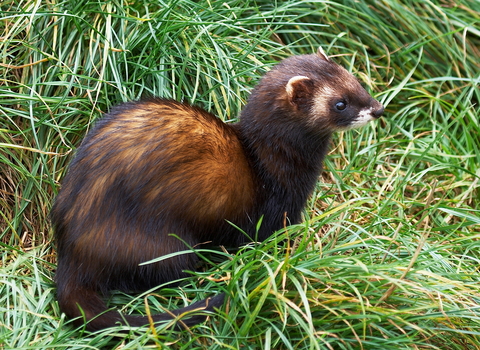
Polecat © Elliot Smith
Polecat
Scientific name
Mustela putoriusWhen to see
January to DecemberSpecies information
About
A member of the mustelid family, which includes the stoat and badger, the polecat is roughly the size of a ferret - its domesticated cousin. Brought to the brink of extinction through persecution, the polecat has been undergoing a recovery recently and can be found in rural Wales and parts of England.Polecats set up home in lowland wooded habitats, marshes, along riverbanks, or even in farm buildings or dry stone walls. They particularly prey on rabbits and may be found in rabbit burrows. They have one litter of five to ten young a year in early summer.
How to identify
The polecat has a two-tone coat: dark brown guard hairs cover a buff-coloured underfur. It has a distinct bandit-like appearance, with white stripes across its dark face. It has a short, dark tail and rounded ears. Polecats do sometimes produce young with escaped ferrets; these hybrids tend to have lighter, creamier fur on their back and more white on their faces, extending past their ears.Distribution
Found in Wales, parts of Scotland, and parts of central, southern and eastern England.In our area
Despite popular belief, true polecats are not found on the Isle of Man. Scientists have confirmed that the animals that many erroneously refer to as either "polecats" or "polecat-ferrets" on the Island are actually feral ferrets, which admittedly do look very similar to wild polecats, although, like typical ferrets, they tend to be paler in colour.
The historic native status of polecat on the Isle of Man is unknown, however there are no records from the last few centuries. From medieval times, a large and widespread population of feral ferrets has become established, likely originally imported to hunt rabbits, which were once an important source of food for the human population. Today, the population of feral ferrets is found throughout the Island, with the individuals closely resembling the appearance of wild polecats, however DNA profiling conducted in 1999 finally confirmed what many suspected, that the animals that we have are not native as was formerly believed by some, but rather escaped kept animals that have established their own, self-supporting population.
These fierce little animals survive quite happily here and are found in all parts of the Island, thankfully, with the exception of the Calf of Man. In ecological terms, as voracious predators of native small mammals, birds, frogs and lizards, they likely represent one of our greatest challenges posed by any invasive, non-native species.
For more information, please see Chiverrell, R. & Thomas, G. (Eds.) (2006), A New History of the Isle of Man: Volume 1: The Evolution of the Natural Landscape, pp. 299 & 417.
Did you know?
Perceived as bloodthirsty animals, polecats were declared vermin during the reign of Elizabeth I and the name 'polecat' was used to refer to vagabonds. Despite their reputation as pests of poultry, polecats eat small rodents, frogs, birds and snakes during their nocturnal hunting forays. They will slowly stalk their prey, seizing it and killing it with a swift bite to the neck.Despite popular belief, true polecats are not found on the Isle of Man. Scientists have confirmed that the animals that many erroneously refer to as either "polecats" or "polecat-ferrets" on the Island are actually feral ferrets, which admittedly do look very similar to wild polecats, although, like typical ferrets, they tend to be paler in colour.
The historic native status of polecat on the Isle of Man is unknown, however there are no records from the last few centuries. From medieval times, a large and widespread population of feral ferrets has become established, likely originally imported to hunt rabbits, which were once an important source of food for the human population. Today, the population of feral ferrets is found throughout the Island, with the individuals closely resembling the appearance of wild polecats, however DNA profiling conducted in 1999 finally confirmed what many suspected, that the animals that we have are not native as was formerly believed by some, but rather escaped kept animals that have established their own, self-supporting population.
These fierce little animals survive quite happily here and are found in all parts of the Island, thankfully, with the exception of the Calf of Man. In ecological terms, as voracious predators of native small mammals, birds, frogs and lizards, they likely represent one of our greatest challenges posed by any invasive, non-native species.
For more information, please see Chiverrell, R. & Thomas, G. (Eds.) (2006), A New History of the Isle of Man: Volume 1: The Evolution of the Natural Landscape, pp. 299 & 417.
